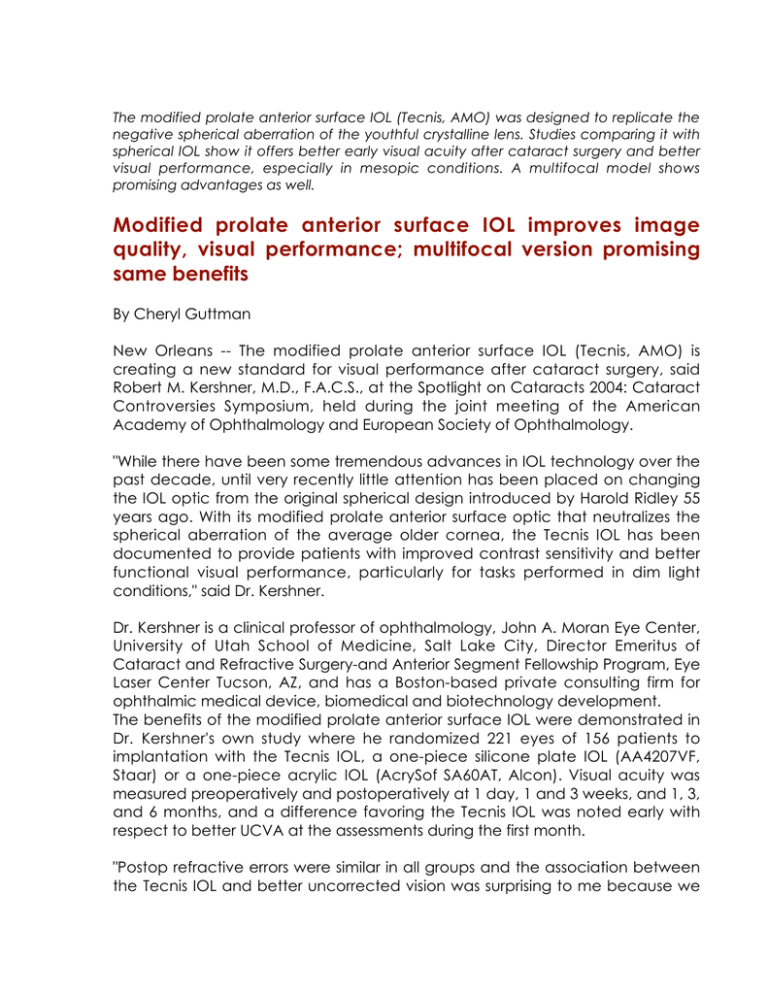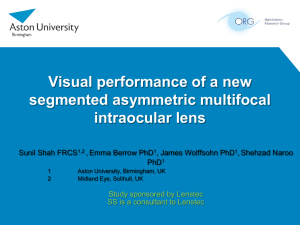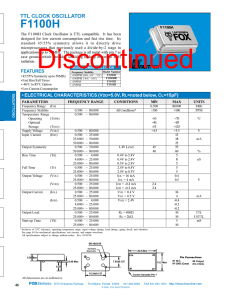Tecnis IOL Improves Functional Vision - Eye Laser Center
advertisement

The modified prolate anterior surface IOL (Tecnis, AMO) was designed to replicate the negative spherical aberration of the youthful crystalline lens. Studies comparing it with spherical IOL show it offers better early visual acuity after cataract surgery and better visual performance, especially in mesopic conditions. A multifocal model shows promising advantages as well. Modified prolate anterior surface IOL improves image quality, visual performance; multifocal version promising same benefits By Cheryl Guttman New Orleans -- The modified prolate anterior surface IOL (Tecnis, AMO) is creating a new standard for visual performance after cataract surgery, said Robert M. Kershner, M.D., F.A.C.S., at the Spotlight on Cataracts 2004: Cataract Controversies Symposium, held during the joint meeting of the American Academy of Ophthalmology and European Society of Ophthalmology. "While there have been some tremendous advances in IOL technology over the past decade, until very recently little attention has been placed on changing the IOL optic from the original spherical design introduced by Harold Ridley 55 years ago. With its modified prolate anterior surface optic that neutralizes the spherical aberration of the average older cornea, the Tecnis IOL has been documented to provide patients with improved contrast sensitivity and better functional visual performance, particularly for tasks performed in dim light conditions," said Dr. Kershner. Dr. Kershner is a clinical professor of ophthalmology, John A. Moran Eye Center, University of Utah School of Medicine, Salt Lake City, Director Emeritus of Cataract and Refractive Surgery-and Anterior Segment Fellowship Program, Eye Laser Center Tucson, AZ, and has a Boston-based private consulting firm for ophthalmic medical device, biomedical and biotechnology development. The benefits of the modified prolate anterior surface IOL were demonstrated in Dr. Kershner's own study where he randomized 221 eyes of 156 patients to implantation with the Tecnis IOL, a one-piece silicone plate IOL (AA4207VF, Staar) or a one-piece acrylic IOL (AcrySof SA60AT, Alcon). Visual acuity was measured preoperatively and postoperatively at 1 day, 1 and 3 weeks, and 1, 3, and 6 months, and a difference favoring the Tecnis IOL was noted early with respect to better UCVA at the assessments during the first month. "Postop refractive errors were similar in all groups and the association between the Tecnis IOL and better uncorrected vision was surprising to me because we have become so accustomed to achieving rapid return to excellent uncorrected vision in our contemporary cataract surgery. However, the reason why the Tecnis IOL seems to perform even better is that it improves contrast and so works particularly well in the situation of high-contrast testing using the Snellen acuity chart," Dr. Kershner observed. The benefits of the Tecnis IOL for improving contrast were noted in analyses of data collected from photopic and mesopic functional acuity contrast testing performed before surgery and at the 3-month postop visit. Compared with preoperatively, the Tecnis IOL offered an approximate 40% improvement in contrast perception in photopic testing with and without glare, and it enhanced contrast performance to an even greater degree under low contrast situations. In mesopic testing with and without glare, patients benefited with improvements of up to 100%, Dr. Kershner said. In contrast, the spherical acrylic IOL had no effect on photopic vision contrast and was generally associated with lesser increases than the Tecnis IOL in the other tests, while no improvement from preoperatively was noted in contrast testing in eyes implanted with the spherical silicone IOL. Dr. Kershner further evaluated the visual performance of the three IOLs using digital analysis of images from fundus photography. Those studies showed improvement in clarity of the image with all three IOLs when comparing the preoperative and post-cataract surgery results. However, only the Tecnis IOL was associated with increased contrast as well. "So the images we are seeing of the fundus through the Tecnis IOL are substantially better compared with those seen in eyes implanted with conventional spherical IOLs," Dr. Kershner said. Nighttime driving simulation studies show the differences associated with the Tecnis IOL translate into benefits for improved functional vision performance, and that is recognized in its labeling. Relative to a control group implanted with a conventional acrylic IOL, older patients with the Tecnis IOL identified a pedestrian target more than 0.5 seconds earlier. When traveling at 55 mph, that time differences allows for 45 foot stopping distance advantage, noted Dr. Kershner. "Auto accidents are more common among elderly drivers and more likely to be fatal. However, by simply changing the optic of our IOL without doing anything else, we are able to offer our patients improved safety. If you consider nothing else, that is an important benefit," Dr. Kershner said. He noted that the multifocal version of the Tecnis IOL, which still features the modified prolate anterior surface but has a diffractive component on the posterior part of the optic, has been shown to give a good range of vision for both near and far tasks. However, because of its ability to improve contrast, it is expected to be a major advance over other multifocal IOLs. "One of the problems with conventional multifocal IOLs is their association with an approximate 27% decrease in contrast, and that is something patients complain about. By neutralizing the spherical aberration that contributes to the contrast loss, the multifocal Tecnis IOL should improve functional vision," Dr. Kershner said. Results of laser refractometry studies performed with the multifocal Tecnis IOL are consistent with that concept. Those investigations used a model of an average cornea with a 5-mm pupil, a US Air Force ANSI target with typical testing conditions for IOLs, and compared the multifocal Tecnis IOL with the pseudoaccommodative multifocal IOL with diffractive optics (AcrySof ReSTOR, Alcon). With the Tecnis IOL, similarly good image quality was obtained at near and far whereas the spherical multifocal IOL demonstrated poor contrast and image quality that was greater for the distance imaging than near. "This bench work confirms what we found for the Tecnis monfocal IOL - namely the image quality is superior to conventional spherical optics. Considering that almost a quarter of the image degradation from a multifocal IOL could be due to spherical aberration alone, the Tecnis is predicted to improve image quality by eliminating this aberration. Clinical trials underway are confirming what we found in the lab," Dr. Kershner said. Dr. Kershner has no financial interest in the Tecnis IOL. ©March 2005, Ophthalmology Times,





